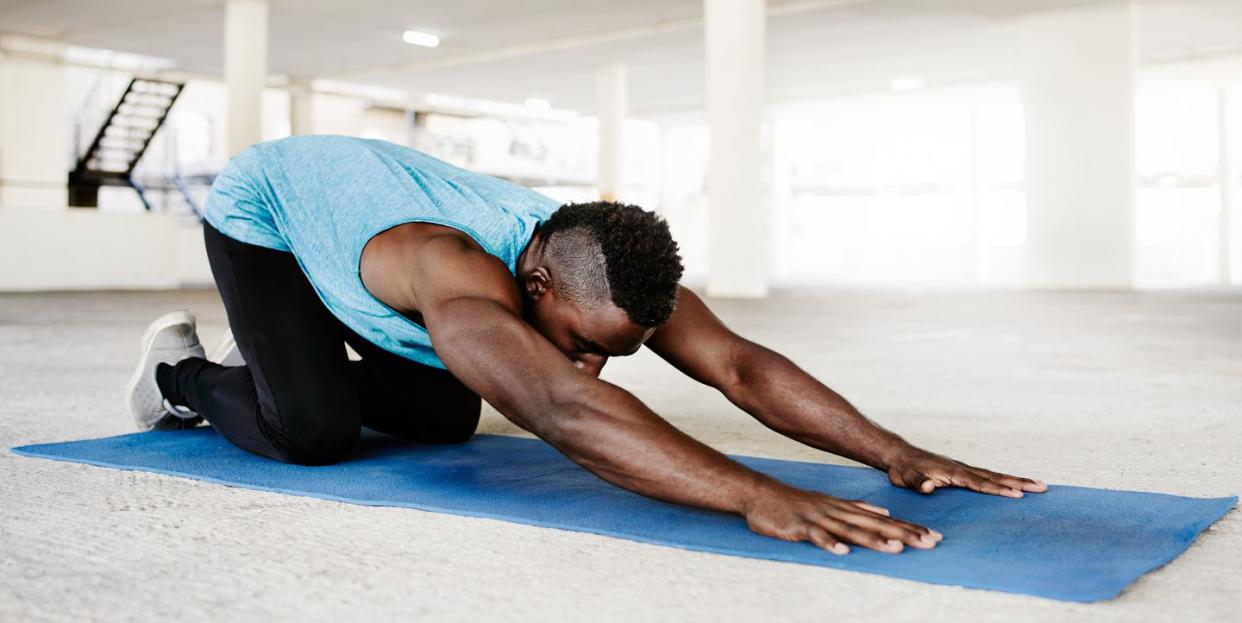How to Make Yourself Fart

You know that feeling—your belly is bloated and hard to the touch, and you just can’t seem to let yourself fart to get some relief. It’s frustrating, not to mention incredibly uncomfortable.
First off, there’s nothing wrong with passing gas, so don’t be embarrassed about the urge. “Farting is a completely normal bodily function. In fact, the average person passes gas anywhere between 15 to 25 times a day,” says Niket Sonpal, MD, a new York City gastroenterologist and assistant clinical professor at Touro College of Medicine. (Not all that unusual to do it while working out, either.)
Farting is a sign that we're healthy, and that the digestive system is functioning correctly. Of course, some foods make you do it more than others (see which ones are the worst). “It's only when farting, or lack of, becomes disruptive in someone's life, that it could signal something more serious,” he says. Constipation can be a reason you can’t let that gas go (here’s what to eat to prevent constipation in the future). Sometimes, though, it’s just a matter of getting in the right position, drinking the right fluids, or maybe even taking an OTC medication to help yourself out.
All jokes about asking a 13-year-old how to make yourself fart aside, here’s how to do it:
Drink a sparkling beverage
Go for bubbles when you need to let that gas out. “When you have a fizzy drink, air builds up in your stomach, causing abdominal distention. This air has to exit the body somehow, and that's almost always through burping or farting,” he says. So, try a low sugar soda, sparkling water, or even a glass of sparkling wine or a beer. Of course, these very drinks can be causing the problem in the first place. If so, keep going and try the strategies below.
Do some yoga poses
These yoga moves can help release the pent-up gas:
Child’s Pose. “This is a yoga pose that can help release built-up gas. Child's pose relaxes the hips and lower back, providing smoother transition for the bowels,” says Dr. Sonpal. To get in this position, start by kneeling on your hands and legs. Then, push your bottom back to sit on your heels. Touching the mat, stretch out the arms in front of your body as you let your headrest on the floor. “This will create gentle pressure on the abdomen, promoting flatulence,” he says. Make sure to take deep breaths and wait until the gas passes.
Knee to Chest Pose. Lying on your back, bring your knees up close to your chest. While doing this, tuck your chin into the chest and hold for 30 seconds. This will apply pressure on the abdomen and help you release gas.
Seated Forward Pose. Sit upright on the floor with the legs stretched out in front of you. Bend forward from the hips and try placing the chest on the knees, or getting as close as possible, without bending the knees (don’t force anything here—or in any of these poses, and stay away from this one if you have back problems). Reach out to touch the toes as much as you can. This can get things going and help you fart with ease.
Change how you sit
"You may have also heard about the squatty potty,” Dr. Sonpal says. “While I don’t recommend any particular brand, it is helpful to have a more effectively angled position when going to the restroom; the alignment of the body may help people better expulse gases without having to push too hard or spend excessive time on the toilet," he says.
Consider an OTC medication
Products containing simethicone may help—“just consult your doctor to make sure they are ok for you to use, and make sure you use them according to the instructions," Dr. Sonpal says.
When ingested, simethicone can reduce the accumulation of gases in the digestive system after a big meal by actually making it easier for those gases to come together, so they can then be discharged. "Simethicone doesn’t really affect the odor, or sound production of your farts, though," he says, so don't think taking it won't make it silent and sneaky. "But the pressure and discomfort of built-up gases will be relieved," he says, and there’s a lot to be said for that.
You Might Also Like

